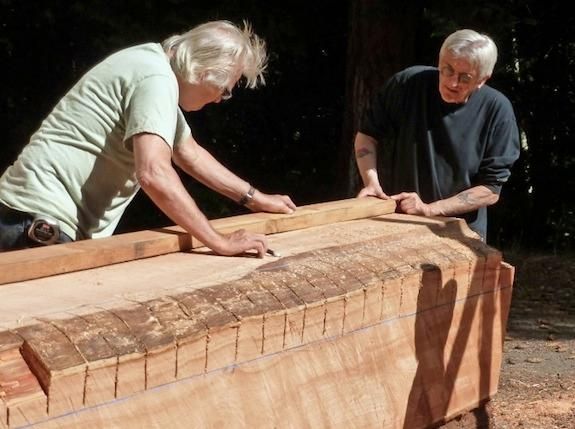A Pair of Monumental Sculptures Makes Its Way to American Indian Museum
Artist Rick Bartow’s pair of sculptures, “We Were Always Here,” will sit at the museum’s entrance
/https://tf-cmsv2-smithsonianmag-media.s3.amazonaws.com/filer/20120905102009010NMAI_Bartow_July2012e022-THUMBNAIL.jpg)
When the American Indian Museum talked to artist Rick Bartow about designing two monumental sculptures to greet visitors to the museum, Bartow had to be sure the museum knew what it was getting into. Though Bartow is from the northern California Wiyot tribe, he says his community has no totem pole tradition, which carries with it its own set of specific iconography and meaning. Museum officials reassured him, they wanted Bartow.
The sculptures, which will be dedicated to the museum Friday, Sept. 21, are columnar multi-figure pieces, but Bartow stresses that they are not totem poles. He told Oregon Live, “We didn’t want a totem pole. There is a predetermined idea of what that is going to look like, a built-in iconography. There are traditions. It reflects family stories, lineages. I have no lineage right to that.”
Instead Bartow says that his tribe built houses, canoes, stools and ladders. “But we had no monumental sculptures, certainly not in the tradition like up the Northwest coast,” says Bartow.
“Rick is very community oriented,” explains Charles Froelick, owner of the Froelick Gallery in Portland where the artist shows his work. His projects, says Froelick, always involve many people. Doctors, lawyers, Native chiefs and everyone in between helped complete the pair of sculptures titled “We Were Always Here.” Many volunteers added to the wave pattern undulating up the surfaces of both sculptures, carving peaks and valleys into the wood. Bartow says he even had one woman who, at 95 couldn’t do much of the carving and heavy lifting involved in the project, simply sign her name in an out-of-the-way location.
The two sculptures, both more than 20 feet tall, feature icons of the Northwest, including the raven, the bear, the salmon and the eagle. Though the role of each of the figures varies across Native traditions, the raven, says Bartow, is generally known as both a trickster and teacher figure, while the bear is known as a protector and healer. All united by their close relation to water, the animals speak to the importance of Earth’s carefully calibrated environment.

But the figures also have personal meaning for Bartow. The bear, for instance, reminds him of his late mentor from the sweat house he attends. The raven represents the passing of his late uncle that coincided with a migration of the birds when they had never previously called that area home.
Working almost every day, the sculptures took a little less than a year to complete. “I’d take Thursdays off to take my mother, who’s 85, to the beauty shop and to lunch,” says Bartow. “Mondays were sweat days, and Saturday and Thursday nights, I played music.”
Bartow’s blues-rock band, the Backseat Drivers, will be playing at the museum on Saturday, September 22, as part of the dedication ceremony, which kicks off Friday, September 21, and marks the autumn equinox. The sculptures began their cross-country trek to Washington, D.C., the day after Labor Day.
“It’s a cherry on my cake, my big lifetime cake,” says Bartow of his work’s installment at the museum. “I don’t know how it gets bigger than this.”
/https://tf-cmsv2-smithsonianmag-media.s3.amazonaws.com/accounts/headshot/Leah-Binkovitz-240.jpg)
/https://tf-cmsv2-smithsonianmag-media.s3.amazonaws.com/accounts/headshot/Leah-Binkovitz-240.jpg)